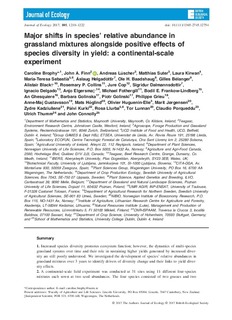| dc.contributor.author | Brophy, Caroline | |
| dc.contributor.author | Finn, John A. | |
| dc.contributor.author | Lüscher, Andreas | |
| dc.contributor.author | Suter, Matthias | |
| dc.contributor.author | Kirwan, Laura | |
| dc.contributor.author | Sebastià, Maria-Teresa | |
| dc.contributor.author | Helgadóttir, Áslaug | |
| dc.contributor.author | Baadshaug, Ole Hans | |
| dc.contributor.author | Bélanger, Gilles | |
| dc.contributor.author | Black, Alistair | |
| dc.contributor.author | Collins, Rosemary P. | |
| dc.contributor.author | Čop, Jure | |
| dc.contributor.author | Dalmannsdottir, Sigridur | |
| dc.contributor.author | Delgado, Ignacio | |
| dc.contributor.author | Elgersma, Anjo | |
| dc.contributor.author | Fothergill, Michael | |
| dc.contributor.author | Frankow-Lindberg, Bodil E. | |
| dc.contributor.author | Ghesquiere, An | |
| dc.contributor.author | Golinska, Barbara | |
| dc.contributor.author | Golinski, Piotr | |
| dc.contributor.author | Grieu, Philippe | |
| dc.contributor.author | Gustavsson, Anne-Maj | |
| dc.contributor.author | Höglind, Mats | |
| dc.contributor.author | Huguenin-Elie, Olivier | |
| dc.contributor.author | Jørgensen, Marit | |
| dc.contributor.author | Kadziuliene, Zydre | |
| dc.contributor.author | Kurki, Päivi | |
| dc.contributor.author | Llurba, Rosa | |
| dc.contributor.author | Lunnan, Tor | |
| dc.contributor.author | Porqueddu, Claudio | |
| dc.contributor.author | Thumm, Ulrich | |
| dc.contributor.author | Connolly, John | |
| dc.date.accessioned | 2018-05-25T07:26:04Z | |
| dc.date.available | 2018-05-25T07:26:04Z | |
| dc.date.created | 2017-11-23T14:02:39Z | |
| dc.date.issued | 2017 | |
| dc.identifier.citation | Journal of Ecology. 2017, 105 (5), 1210-1222. | nb_NO |
| dc.identifier.issn | 0022-0477 | |
| dc.identifier.uri | http://hdl.handle.net/11250/2499172 | |
| dc.description.abstract | 1. Increased species diversity promotes ecosystem function; however, the dynamics of multi-speciesgrassland systems over time and their role in sustaining higher yields generated by increased diver-sity are still poorly understood. We investigated the development of species’ relative abundances ingrassland mixtures over 3 years to identify drivers of diversity change and their links to yield diver-sity effects.2. A continental-scale field experiment was conducted at 31 sites using 11 different four-speci esmixtures each sown at two seed abundances. The four species consisted of two grasses and two legumes, of which one was fast establishing and the other temporally persistent. We modelledthe dynamics of the four-species mixtures, and tested associations with diversity effects on yield.3. We found that species’ dynamics were primarily driven by differences in the relative growth rates(RGRs) of competing species, and secondarily by density dependence and climate. The temporallypersistent grass species typically had the highest RGRs and hence became dominant over time. Den-sity dependence sometimes induced stabilising processes on the dominant species and inhibitedshifts to monoculture. Legumes persisted at most sites at low or medium abundances and persistencewas improved at sites with higher annual minimum temperature.4. Significant diver sity effects were present at the majority of sites in all years and the strength ofdiversity effects was improved with higher legume abundance in the previous year. Observed diver-sity effects, when legumes had declined, may be due to (i) important effects of legumes even at lowabundance, (ii) interaction between the two grass species or (iii) a store of N because of previouspresence of legumes.5. Synthesis. Alongside major compositional changes driven by RGR differences , diversity effectswere observed at most sites, albeit at reduced strength as legumes declined. This evidence stronglysupports the sowing of multi-species mixtures that include legumes over the long-standing practiceof sowing grass monocultures. Careful and strategic selection of the identity of the species used inmixtures is suggested to facilitate the maintenance of species diversity and especially persistence oflegumes over tim e, and to preser ve the strength of yield increases associated with diversity. | nb_NO |
| dc.language.iso | eng | nb_NO |
| dc.title | Major shifts in species' relative abundance in grassland mixtures alongside positive effects of species diversity in yield: a continental-scale experiment | nb_NO |
| dc.type | Journal article | nb_NO |
| dc.description.version | publishedVersion | nb_NO |
| dc.rights.holder | © 2017 The Authors. Journal of Ecology © 2017 British Ecological Society | nb_NO |
| dc.subject.nsi | VDP::Landbruks- og Fiskerifag: 900 | nb_NO |
| dc.source.pagenumber | 1210-1222 | nb_NO |
| dc.source.volume | 105 | nb_NO |
| dc.source.journal | Journal of Ecology | nb_NO |
| dc.source.issue | 5 | nb_NO |
| dc.identifier.doi | 10.1111/1365-2745.12754 | |
| dc.identifier.cristin | 1517721 | |
| dc.relation.project | Internasjonale institusjoner: Science Found. Ireland, grant number 09/RFP/EOB2546 | nb_NO |
| dc.relation.project | EU/FP7/2007-2013; grant agreement no. 266018 | nb_NO |
| dc.relation.project | EU/COST Action 852 | nb_NO |
| cristin.ispublished | true | |
| cristin.fulltext | original | |
| cristin.qualitycode | 2 | |
